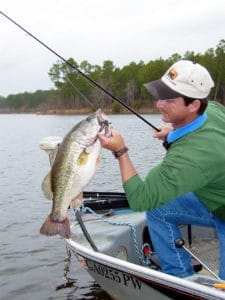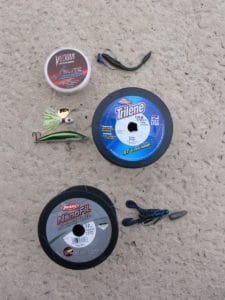by Capt. Bert Deener

Line size and style matters. Complicating the issue is that there are lots of options on the market these days to confuse anglers.
I remember my first heartbreak related to line failure like it was yesterday. I was 12 years old and fishing my grandmother’s pond with my dad’s spinning outfit. A 4-pound bass was cruising the shoreline, and I flipped a plastic worm in its path. As it approached, a little twitch is all it took to get the fish to engulf my offering. The fight only lasted a few head shakes and a strong run before my line popped. Heartbroken, I told the story to my dad and learned that it was probably the original line from when he bought the outfit years before. That was the day, at age 12, I took over managing the line on my fishing outfits. Line is a most-critical component of fishing, but casual anglers often overlook its importance.
Do you remember the days when you were either a Stren or Trilene user? Each brand had its devoted followers, and just like the Ford-Chevy debate, each side made fun of the other for their choice. Then came Trilene XT and XL, Stren Magnathin, etc., etc., etc. Anglers began demanding and companies began designing lines for specific applications. Today, the choice is staggering. If you do not believe me, just stand in front of the line wall at a Bass Pro Shops store. Although there are many variations of each, all the different lines fall into three basic categories – monofilament, fluorocarbon, or braided line. When you understand the properties of the three main types of line, you will more effectively apply the proper one to the fishing situations you encounter.
For decades, monofilament was the only type of line available. I was in my early 20’s when braided line first hit the market. Of course, it was heralded as the only line you needed. Sales of monofilament took a beating when braid was first introduced, but it did not take long for serious anglers to learn that braided line was just like everything else…a tool to be used in certain circumstances.
When I first spooled up with braid, I headed to Lake Oconee to toss spinnerbaits at some big bass I had located. Initially, I loved the extra thump I could feel as the blades turned. On my first flooded brushpile, I hooked a 6-pound class bass. The fish jumped and spit the hook. I was ticked. About three casts later on the very next brushpile, I hooked and jumped off a 7-pound class bass. I was crushed. At least I was not in a tournament. Since that time, I have learned that braid is not my favorite for spinnerbaits because it is too sensitive for me. I have a tendency to set the hook before a bass inhales my offering. By the same token, the extra sensitivity of braid is fantastic when punching through vegetation with a Texas-rigged crawfish and you have to try to detect a bite as the lure works through the matted vegetation.

The author recommends the following line choices: for casting a football-head jig, fluorocarbon line; for fishing a spinnerbait or jerkabit, monofilament; for punching through thick vegetation with a Texas-rigged creature bait, braided line.
Understanding the characteristics of various lines will help you make decisions about which is best for various presentations. Braided line is usually very limp, has virtually no stretch, floats, cuts through vegetation well, and is much more visible in the water (to both humans and fish) compared to the other two lines. In wind, braid is prone to wrap around your rod tip or tie itself into “wind knots”, thus wasting valuable time untangling or retying. Fluorocarbon line is stiff, has little stretch, sinks, is abrasion resistant, and is extremely clear compared to the other two lines. Fluorocarbon has a tendency to burn itself when tightening a knot, thus weakening the knot. Monofilament lines vary but generally are not too stiff, have a memory (coils if it has been on the spool a while), have some stretch, come in a variety of colors to match water conditions or provide better visibility, and are the most affordable of the lines.
Once you understand these properties, you can make the right line choice for each situation you face. There is no cut and dry choice for every situation, but it is a balancing act with the properties of each line. For instance, say, you are going to fish jerkbaits this winter on your favorite lake. I love monofilament for jerkbaits because that extra stretch keeps me from setting the hook too soon, and it also gives the lure better side to side action on the jerk. But, if the lake is gin-clear, like many are during winter, I would opt for my rod rigged with fluorocarbon and give up a little stretch to have a clearer line.
Conversely, when punching a Pure Craw through thick vegetation, I would trade the weed-cutting ability and sensitivity of braid for the moderate sensitivity and clarity of fluorocarbon, even in a clear lake. Now, that clarity and moderate sensitivity of fluorocarbon would be the perfect choice for dragging a football jig down a rocky point on a clear water reservoir. There are endless possibilities, but here are a few situations listed by fishing technique and then my suggested line for that technique.
Topwaters: Mono
Shallow/Mid/Deep Crankbaits: Mono
Jerkbaits: Mono
Jigs (Casting – Football): Fluoro
Jigs (Flipping-Pitching): Mono
Punching Vegetation (TX Rig): Braid
Carolina-rigging: Fluoro
Drop-Shotting and Shaky Heads: Fluoro
Spinnerbaits: Mono
The days of taking one medium-action rod spooled with 12-lb. test and flinging all of your lures are over. Dialing in which line to use in each situation will definitely cash more checks for tournament anglers or put more fish in the cooler for those fishing for meat.
The Union Sportsmen’s Alliance website is designed to provide valuable articles about hunting, fishing and conservation for members of AFL-CIO affiliated labor unions and all sportsmen and sportswomen who appreciate hunting and fishing and want to preserve our outdoor heritage for future generations. If you would like your own story and experience from the outdoors to be considered for our website, please email us at [email protected].



